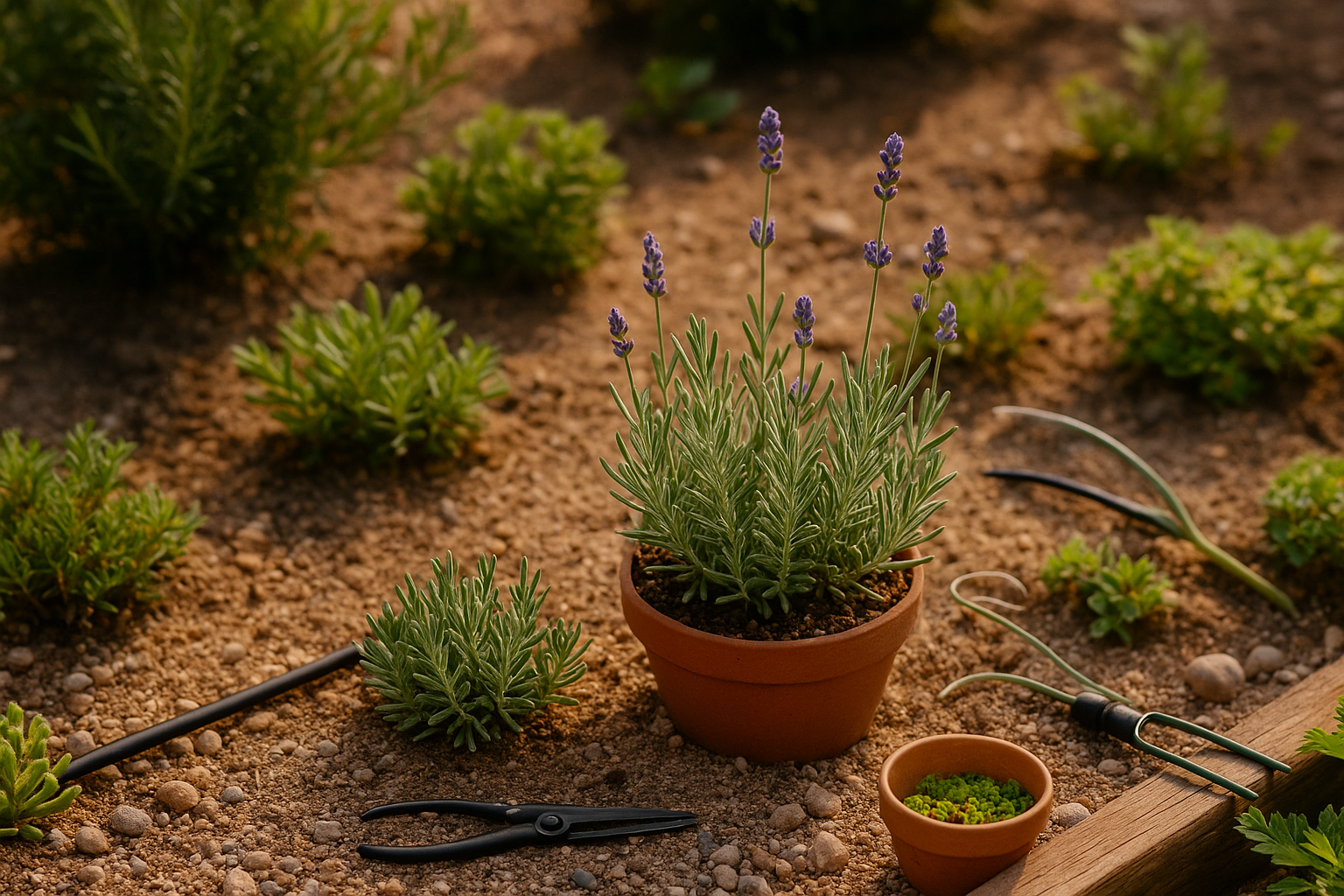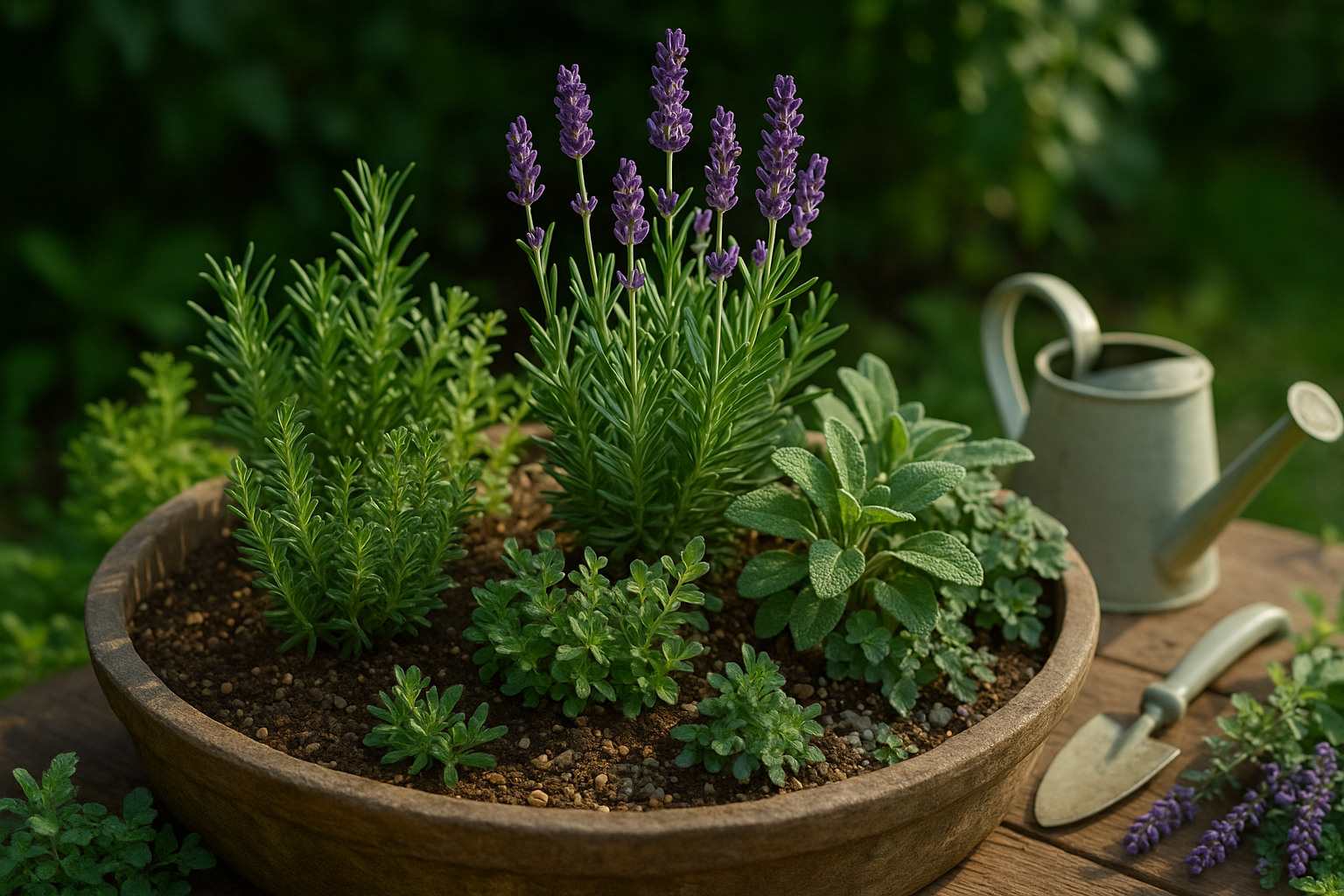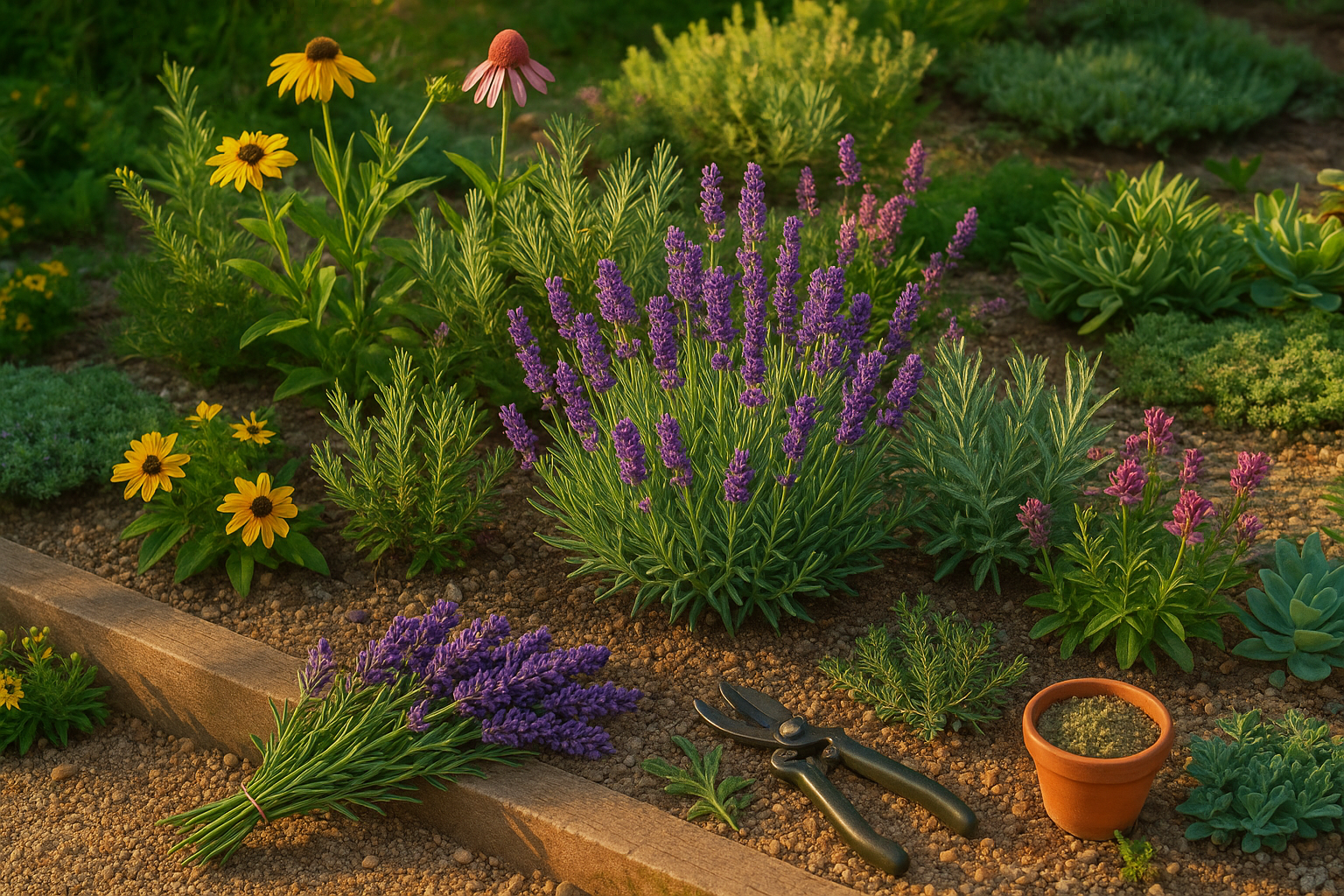Introduction
Lavender companion plants can make all the difference in your garden, whether you’re aiming for a show-stopping ornamental display or a productive edible patch. Companion planting—the practice of grouping mutually beneficial plants together—isn’t just an old gardener’s tale; it can boost pollination, enhance flavors, and even help control pests naturally. For lavender, this is especially true.
Lavender thrives in full sun, loves well-drained, slightly alkaline soil, and prefers to be watered deeply but infrequently—conditions not every plant can handle. That’s why matching lavender with the right neighbors is essential. The right companions not only complement lavender’s growth requirements but can also enhance the beauty and bounty of your garden.
For instance, your rosemary and sage might thrive together, each elevating the other’s fragrance, while low-growing thyme acts as a living mulch to suppress weeds and retain moisture. Whether you want to attract pollinators or simply pair pretty blossoms, choosing lavender companion plants thoughtfully helps create a balanced, resilient, and gorgeous garden environment. With a little planning, your lavender can thrive while supporting and benefiting its botanical friends around it.
Understanding Lavender’s Growing Requirements

Lavender thrives best when given plenty of direct sunlight—at least six to eight hours daily—making it perfect for garden spots that get sun all afternoon. This Mediterranean herb also prefers well-drained, sandy, or gravelly soil, as standing water or heavy clay can quickly cause its roots to rot.
If you live in a humid region, look for drought-tolerant lavender varieties and consider spacing plants well apart to boost airflow, which helps prevent fungal issues. Watering should be kept to a minimum; lavender actually grows more fragrant and robust with a little neglect. Overwatering or rich soil can result in leggy plants with fewer flowers.
When choosing companion plants for lavender, select those that share similar needs—think rosemary, sage, or sedum. These sun-loving, drought-resistant plants won’t compete for water and will help create a harmonious, low-maintenance garden. For example, planting lavender with rosemary not only looks beautiful but also ensures both thrive with minimal attention.
Ultimately, mimicking lavender’s native habitat ensures healthier plants with more vibrant blooms and fragrance, and leads to companion plantings that flourish together without extra fuss.
Best Flower Companions for Lavender
Lavender is a versatile star in ornamental gardens, and pairing it with other flowers not only enhances visual appeal but also offers practical benefits. Coneflowers (Echinacea) are a top pick, thriving in similar sunny, well-drained spots and attracting pollinators like bees and butterflies alongside lavender.
Black-eyed Susans (Rudbeckia) offer cheerful golden blooms that contrast beautifully with lavender’s cool purples, and both enjoy dry, lean soils—making them low-maintenance neighbors. Blanket flowers (Gaillardia) add a splash of bold red and yellow hues, and their drought tolerance matches lavender’s resilience, ensuring the whole bed looks vibrant even during dry spells.
African daisies (Osteospermum), with their dainty, pastel petals, create a romantic palette that complements lavender’s color, and they combine well in modern or cottage-style borders. For a touch of drama, try red hot pokers (Kniphofia), whose spiky, fiery blooms rise above lavender’s mounds, creating dynamic height variation and extra visual intrigue.
Zinnias, too, are sun-lovers that fill hot, open spots with a riot of colors, mixing nicely with lavender’s subtle shades while attracting butterflies for added garden life.
When designing, think about planting in drifts—mass lavender plants in the foreground, and weave in coneflowers or black-eyed Susans for bursts of yellow and pink. Use taller plants like red hot pokers at the back or as vertical accents among lower, spreading varieties. Mixing flower colors and shapes not only maximizes curb appeal but also supports a thriving ecosystem of beneficial insects.
Just be sure all your companions share the same love for full sun and well-drained soil; avoid plants needing heavy watering or shade. For best results, mulch lightly with gravel around groupings for a Mediterranean look that keeps plants dry and happy. By matching their cultural needs and mixing up heights and hues, you’ll create a stunning, harmonious display that stays healthy and lively all season.
Best Herb Companions for Lavender

Lavender thrives when planted alongside other Mediterranean herbs like rosemary, sage, thyme, oregano, and catmint, thanks to their shared preference for full sun and well-drained, low-fertility soil. Grouping these herbs together in garden borders, raised beds, or large containers not only creates a beautiful and fragrant display but also makes care easier since they all require minimal watering and are naturally drought-tolerant.
This shared environment helps prevent overwatering, which lavender and its companions dislike. Another big plus is their collective resistance to common pests—these herbs give off strong scents that repel aphids, moths, and mosquitoes, making them a perfect low-maintenance option for organic gardeners.
For culinary enthusiasts, these companion herbs offer a ready-to-harvest array of flavors:
- Use rosemary and thyme with roasted meats
- Sage in savory sauces
- Oregano in Mediterranean dishes
- Lavender can be infused into desserts or teas
When planting, space each herb 12–18 inches apart to allow for air circulation and healthy growth. Avoid enriching the soil with compost, as these plants prefer lean conditions. For containers, choose a gritty potting mix and ensure pots have good drainage holes; this helps prevent root rot, a common issue for Mediterranean herbs.
Interplanting these herbs not only maximizes space and minimizes weeds but also ensures your herb garden is as functional as it is visually appealing throughout the growing season.
Other Useful Companion Plants
Beyond flowers and classic culinary herbs, several other companion plants can make excellent partners for lavender while boosting your garden’s health and resilience. Alliums—think garlic, onions, and chives—emit a pungent scent that naturally deters aphids, carrot flies, and other harmful pests, offering a line of defense for lavender and surrounding plants.
Yarrow stands out for its feathery foliage and clusters of tiny blooms, attracting ladybugs and lacewings that help control common pests. This plant also thrives in poor soils and withstands drought, making it a reliable neighbor for lavender’s similar low-water needs.
Globe thistle adds unique texture with its striking, spiky spheres, drawing beneficial pollinators while resisting deer and rabbits that might snack on more vulnerable plants. Sedum, a hardy succulent, is an excellent groundcover choice that conserves soil moisture and adds a sculptural, modern look to your planting scheme.
All of these companions enhance garden aesthetics with contrasting shapes, colors, and year-round interest, while sharing lavender’s preference for full sun and dry conditions. By mixing these tough, functional plants around your lavender, you create a visually appealing, low-maintenance garden that’s well-equipped to fend off pests and survive dry spells, all while supporting local pollinators and beneficial insects.
What NOT to Plant with Lavender
When planning your garden, it’s important to avoid pairing lavender with plants that have different needs, especially those that require more water, richer soil, or shadier conditions. For example, shade-lovers like impatiens, hostas, and ferns thrive in moist, nutrient-rich environments—the exact opposite of what lavender prefers.
Many types of vegetables, like lettuce and spinach, also need damp, fertile soil, which can lead to problems such as root rot or fungal disease for lavender planted nearby. Likewise, thirsty annuals like begonias, as well as certain herbs like basil and mint, can outcompete lavender for moisture and nutrients, leaving your lavender struggling and possibly stunted.
To keep both lavender and incompatible plants healthy, try grouping plants with similar needs together in separate beds or containers. You might dedicate a sunny, well-drained spot to a mix of drought-tolerant Mediterranean herbs (such as rosemary, thyme, and oregano) alongside lavender, while reserving a partially shaded, richer area for lush ornamentals and veggies.
If space is tight, use raised beds or pots to control soil type and watering routines more precisely, ensuring that each plant gets the conditions it loves without compromise. This way, your lavender stays vibrant and healthy, while your moisture-loving plants flourish just as they should.
Key Tips for Successful Lavender Companion Planting
When it comes to successful lavender companion planting, smart planning makes all the difference. Give your lavender ample space—at least 18 to 24 inches between each plant and its companions—so air flows freely and prevents fungal diseases.
Lavender thrives in well-drained, slightly alkaline soil, so before planting, work a handful of lime or crushed eggshells into the soil and mix in organic compost to boost nutrients. Avoid overwatering; lavender prefers to dry out a bit between watering sessions, so always check that the top inch of soil feels dry before reaching for the hose.
In spring, trim away dead or weak stems to promote healthy new growth, and mulch with light gravel to help keep roots cool while improving drainage. Through the summer, keep an eye out for fast-growing neighbors that may overshadow your lavender and give them a gentle trim if needed.
Remember, gardening is as much art as science—don’t hesitate to try pairing lavender with different herbs or flowers like rosemary, echinacea, or yarrow. Each garden is unique, so keep notes on what works best in your yard and adjust your setup season by season for the healthiest, most beautiful results.
Conclusion
Pairing lavender with the right companion plants can enhance your garden’s beauty, boost pollinator visits, and even help control pests naturally. Whether you’ve enjoyed the classic combination of lavender and roses or discovered a unique pairing with thyme or sage, there’s no shortage of creative possibilities.
We’d love to hear which plant partnerships have worked best for you, so please share your favorite combinations and stories in the comments below. As you plan your next gardening season, consider experimenting with companion planting to see firsthand how thoughtful choices can transform your outdoor space. Happy gardening!
